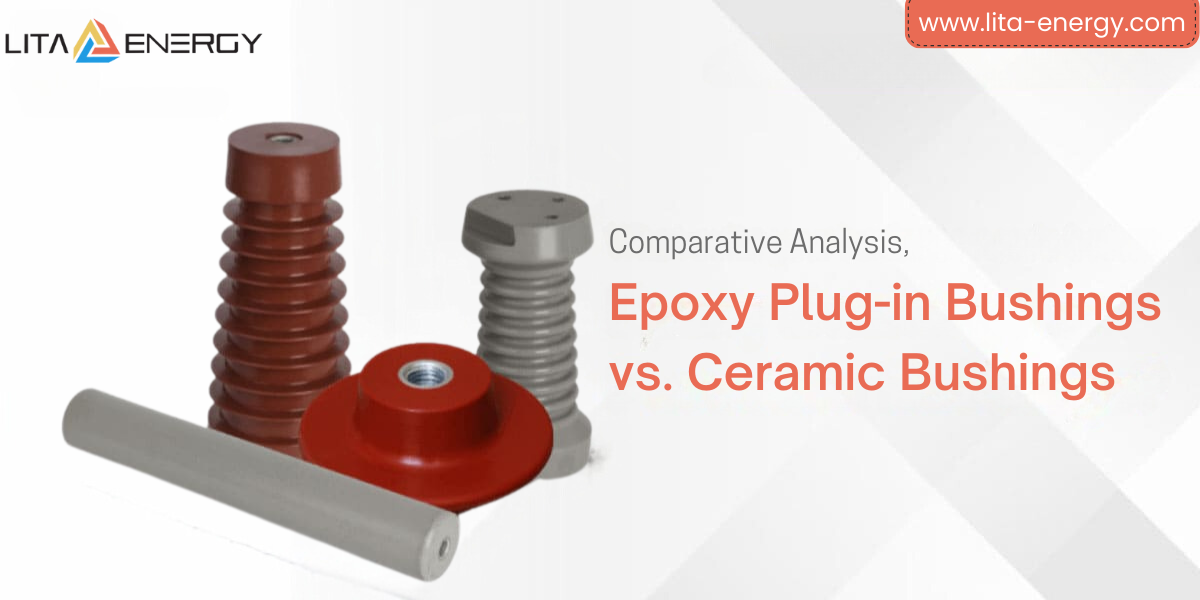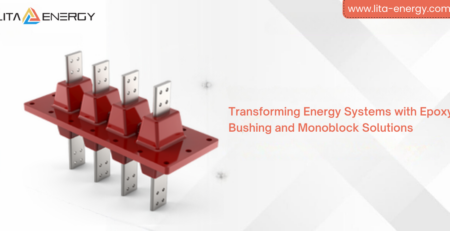Comparative Analysis: Epoxy Plug-in Bushings vs. Ceramic Bushings
In the electrical power industry, bushings play a critical role in ensuring the safe and efficient operation of equipment such as transformers, circuit breakers, and switchgear. Two popular types of bushings used in this field are Epoxy Plug-in Bushings and Ceramic Bushings. This article provides an overview of these two types of bushings, highlighting their characteristics, advantages, disadvantages, and applications. At Lita Energy, we specialize in providing high-quality epoxy bushing solutions tailored to meet modern industry needs.
Epoxy Plug-in Bushings
Epoxy plug-in bushings are modern insulating components made from epoxy resin, a high-performance polymer known for its excellent electrical, thermal, and mechanical properties. These bushings are widely used in medium- and high-voltage applications due to their versatility and reliability.
Advantages of Epoxy Plug-in Bushings
Compact and Lightweight Design:
– Epoxy bushings are significantly lighter than ceramic bushings, making them easier to transport and install.
High Electrical Performance:
– They exhibit superior dielectric strength and insulation resistance, ensuring efficient performance under high-voltage conditions.
Durability and Mechanical Strength:
– Epoxy bushings are highly resistant to mechanical stress, vibration, and impact, making them suitable for harsh operating environments.
Moisture and Pollution Resistance:
– The non-porous surface of epoxy resin provides excellent resistance to moisture and contamination, reducing the risk of electrical leakage and failure.
Cost-effectiveness:
– Epoxy plug-in bushings are generally more cost-effective than ceramic bushings, offering a favorable balance between price and performance.
Customizability:
– Epoxy bushings can be manufactured in complex shapes and sizes, allowing for design flexibility to meet specific customer requirements.
Low Maintenance Requirements:
– Epoxy bushings require minimal upkeep, making them ideal for installations in remote or hard-to-access areas.
Disadvantages of Epoxy Plug-in Bushings
Thermal Limitations: Epoxy materials may degrade under prolonged exposure to high temperatures, making them less suitable for extremely high-temperature environments.
Aging Under UV Exposure: Prolonged exposure to ultraviolet (UV) radiation can cause surface degradation, although protective coatings can mitigate this issue.
Ceramic Bushings
Ceramic bushings are traditional insulating components made from high-strength porcelain or alumina. They have been used extensively in power systems for decades and remain a popular choice for certain high-voltage applications.
Advantages of Ceramic Bushings
Exceptional Thermal Stability:
– Ceramic bushings can withstand very high operating temperatures, making them ideal for extreme thermal environments.
Long Lifespan:
– The inherent durability of ceramic materials ensures a longer operational life, often exceeding several decades with proper maintenance.
Resistance to Aging:
– Unlike epoxy, ceramics are not affected by UV radiation or other environmental factors, maintaining their integrity over time.
High Voltage Handling:
– Ceramic bushings are well-suited for ultra-high voltage applications, where reliability and performance are critical.
Low Sensitivity to Environmental Factors:
– Ceramics are less affected by pollutants and extreme weather conditions, ensuring consistent performance.
Disadvantages of Ceramic Bushings
Heavy and Bulky:
– Ceramic bushings are significantly heavier, leading to increased transportation and installation costs.
Fragility:
– Although strong, ceramics are brittle and can crack or shatter under mechanical impact or stress.
Higher Manufacturing Costs:
– The production process for ceramic bushings is more labor-intensive and expensive compared to epoxy bushings.
Porosity Issues:
– Ceramics may absorb moisture over time if not properly glazed, leading to potential insulation problems.
Higher Maintenance Requirements:
– Ceramic bushings may require periodic inspection and cleaning to prevent issues caused by surface contamination.
Key Comparisons: Epoxy Plug-in Bushings vs. Ceramic Bushings
|
Feature |
Epoxy Plug-in Bushings |
Ceramic Bushings |
|
Weight |
Lightweight |
Heavy and bulky |
|
Thermal Resistance |
Moderate |
High |
|
Electrical Performance |
Excellent |
Excellent |
|
Durability |
High resistance to impact |
Brittle under mechanical stress |
|
Cost |
Cost-effective |
Higher production costs |
|
Environmental Aging |
UV-sensitive |
UV-resistant |
|
Customizability |
Highly customizable |
Limited |
|
Maintenance |
Minimal upkeep required |
Periodic inspection and cleaning |
Applications and Recommendations
Epoxy Plug-in Bushings
– Best suited for:
– Medium- and high-voltage applications.
– Environments with high moisture or pollution levels.
– Projects requiring lightweight and compact designs.
At Lita Energy, our epoxy bushing solutions are engineered to meet the demanding needs of modern electrical systems, providing unmatched reliability and performance.
Ceramic Bushings
– Best suited for:
– Ultra-high voltage applications.
– Thermal-intensive environments such as heavy industrial zones.
– Installations requiring long operational lifespans.
Conclusion
Both epoxy plug-in bushings and ceramic bushings have unique advantages and limitations, making them suitable for different applications. While ceramic bushings excel in extreme thermal and ultra-high voltage environments, epoxy plug-in bushings offer versatility, cost-efficiency, and modern performance benefits. At **Lita Energy**, we are committed to helping our customers select the right bushing solution for their specific needs, ensuring optimal performance and reliability in every project.



